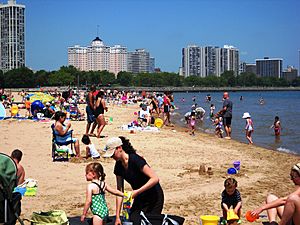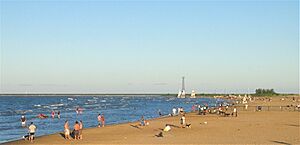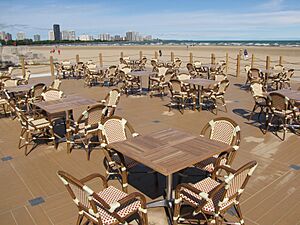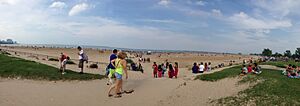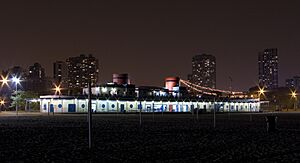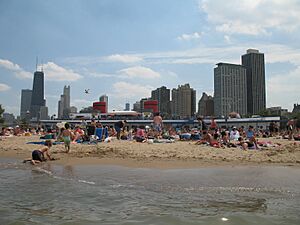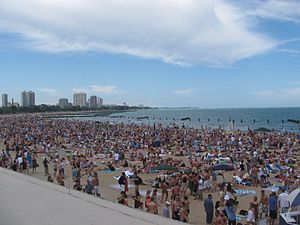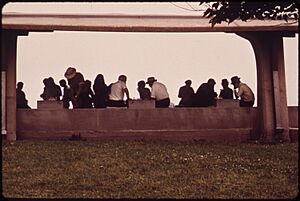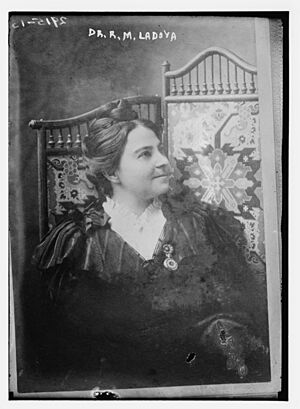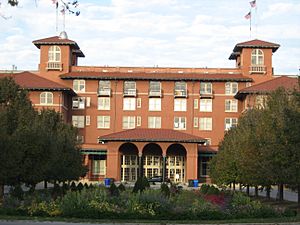List of beaches in Chicago facts for kids
The beaches in Chicago are amazing places to have fun along the water! They are managed by the Chicago Park District. Chicago's waterfront includes parts of Lake Michigan and several rivers like the Chicago River, Des Plaines River, and Calumet River.
Long ago, people used the rivers for fishing, swimming, and boating. But as industries grew, many fun activities moved to Lake Michigan. The very first public beach in Chicago opened in Lincoln Park in 1895. Today, the entire 28-mile (45 km) Chicago lakefront is mostly public parks. You can find 24 sandy beaches along the freshwater shores of Lake Michigan!
Contents
History of Chicago's Beaches
Chicago's first sandy beaches formed naturally from sand moving along the shoreline. But these beaches often changed shape and eroded away. When Chicago built piers (long structures extending into the lake), large sandy beaches often formed north of them because sand would get trapped there.
In the late 1800s, public swimming was not allowed. But many people wanted public places to swim. So, the city decided to open public beaches to meet this demand. The first public bathing beach opened in 1895 in Lincoln Park. The city then took responsibility for keeping the beaches nice.
By 1900, the lakefront was divided for different uses, like recreation, homes, and industry. Concerns about Lake Michigan's water quality led to big changes, like reversing the flow of the Chicago River. The 1909 Burnham Plan helped develop the lakefront even more. A man named Aaron Montgomery Ward believed that everyone should have access to the lake. His ideas helped create parks like Jackson, Burnham, Grant, and Lincoln Park.
More public support led to many new city beaches opening in the 1910s. Today's beaches are made from sand brought in by lake currents. Sometimes, sand is also brought from old sand-pits or dredged from the lake bottom. In 2013, some beaches, like North Avenue Beach and Kathy Osterman Beach, even started offering free Wi-Fi!
Rogers Park Beaches
The Rogers Park neighborhood in the far north has several small "street-end" beaches. Unlike most Chicago beaches, these are often separated by private land. This means you can't always walk from one to another along the shore.
Juneway Terrace Beach
Juneway Terrace Beach is the northernmost beach in Chicago. It's located at 7800 North along Lake Michigan. It's part of Rogers Avenue Beach and Park. A rocky barrier called rip rap separates it from Rogers Beach.
Rogers Beach
Rogers Beach is in Rogers Avenue Beach and Park at 7705 North. This park is barely one block long and also has tennis courts. Due to recent storms, the beach is being replaced with riprap to protect the shoreline.
Howard Beach
Howard Beach is in Howard Street Beach and Park at 7600 North. It's just south of Howard Street and is about 213 feet (65 m) long. This beach is also being changed due to lake erosion.
Marion Mahony Griffin Beach (Jarvis/Fargo)
This beach is located near Jarvis Street (7400 North) and Fargo Street (7432 North). Rocky barriers offshore help reduce erosion here. This beach is about three blocks long.
In 2015, the beach was named after Marion Mahony Griffin. She was an architect who helped design the Australian capital city of Canberra. She lived near this beach when she returned to the U.S. in 1939.
Loyola/Leone Beach
Leone Beach is Chicago's largest beach. It starts near North Sheridan Road and stretches for eight blocks.
Tobey Prinz (Pratt) Beach
This beach is connected to Leone/Loyola Beach at 1050 West Pratt Boulevard. It used to be called Pratt Boulevard Beach. In 2014, it was renamed for Tobey Prinz, a local community activist. There's a fishing pier here, and you can sometimes catch salmon in the fall.
Hartigan Beach
Also known as Albion Beach, this beach is connected to North Shore Beach. It's located at 6600 North and ends just north of Loyola Avenue. It's named after former local politician David L. Hartigan.
Columbia Beach
Columbia Beach is located at 6726 North.
North Shore Beach
North Shore Beach is located at 6700 North.
Hamilton Beach
Hamilton Beach is currently closed because of a project to dig up sand from the lake bottom. It is actually non-existent.
Berger Park Beach
Berger Park Beach is a small beach in Edgewater. It's at the northeast corner of Berger Park. The park also has a cultural center and a cafe by the lake. There's also a playground for kids.
North-Side Beaches
Lincoln Park is Chicago's biggest public park. It has many of the city's north side lakefront beaches. These beaches run for seven miles (11 km) through several neighborhoods.
Lane Beach Park (formerly Thorndale Beach)
Lane Beach Park, often called Thorndale Beach, is at 5932 North in Edgewater. It's near Sheridan Road and Thorndale Avenue. This beach used to be separate but later connected to Hollywood Beach. Recently, winter waves carried away much of the sand, making it separate again.
There's a ramp here for strollers or wheelchairs to get closer to the water. There's also a modern playground for children. The park and beach are named after George A. Lane, a Chicago lawyer who helped develop the community.
Kathy Osterman Beach (formerly Hollywood Beach)
This beach is located at the 5800 North block in Edgewater. It's a crescent-shaped beach. The northern part of the beach has shallow water, which is great for kids. There's a long ramp for strollers and wheelchairs near the Ardmore Avenue entrance. Beach volleyball is very popular here. There's also a beach house and a place to buy snacks, which opened in 2010.
North of Ardmore, near Thorndale beach, there's a small area of beach grass. This area is a reserve for migrating birds and butterflies.
Foster Avenue Beach
Foster Avenue Beach is located at 5200 North. It's a popular beach in the Edgewater area. This beach was part of Lincoln Park's final expansion in the 1950s. A new beach house with better facilities was built in the 1990s.
Montrose Avenue Beach
Montrose Beach is Chicago's largest beach. It's located in Uptown. It also has the most parking of any beach in Chicago. It's one of the few beaches where you can launch non-motorized boats like kayaks. It also has one of only two dog beaches in the Chicago Park District. This makes it a favorite for dog owners! Dogs are allowed off-leash in a fenced-off area at the north end.
Montrose Beach hosts many events, like the Junior Guard championships and the annual Beach Soccer Festival. The beach house looks like an old lake steamer. It was remodeled with a large patio deck and has a restaurant called "The Dock at Montrose Beach." This was part of a plan to add nicer food options to the lakefront. Montrose Beach is also where the north side's July 4th fireworks display is held each year.
North Avenue Beach
North Avenue Beach, located at 1600 North, is often called Chicago's best beach. It has the most lifeguards and the most developed beach house. It runs from North Avenue to Diversey Harbor in the Lincoln Park neighborhood. The beach has piers that keep the sand in place, creating a unique scalloped shoreline.
This beach hosts international volleyball tournaments and millions of visitors each year. The Chicago Park District sets up poles for volleyball nets. The beach and the nearby bike path attract many people. North Avenue Beach is also the main spot for the Chicago Air & Water Show, which brings over a million people to the lakefront. It's also the site of the annual AVP Chicago Open volleyball tournament.
The beach house looks like an ocean liner. It has bike and sports equipment rentals, a bar and restaurant (Castaways), a snack stand, a lifeguard station, and restrooms.
Oak Street Beach
Oak Street Beach, at 1000 North, stretches south from the North Avenue 'Hook' Pier to Ohio Street Beach. This is about 1.5 miles (2.4 km) long. Oak Street has the largest area for deep water swimming in the city. It was once the only place in the city where SCUBA divers could dive close to shore.
Oak Street Beach is a popular spot for sunbathers, runners, skaters, and bikers. It used to be the city's most popular beach because it's so close to downtown. Oak Street Beach also has Chicago's only chess pavilion and an outdoor restaurant called the Oak Street Beachstro. This restaurant is set up every summer and taken down at the end of the season.
Ohio Street Beach
This beach is in Lincoln Park, next to Addams Memorial Park and Olive Park. It's just north of Ohio Street (600 N) and east of Lake Shore Drive. It faces north, which is unusual, because it formed in a bay created by the Jardine Water Purification Plant that extends into the lake.
Because of its unique direction, Ohio Street Beach is a great place to train for open water swimming. You can swim north for 0.5 miles (800 m) to the Oak Street curve and always be close to the seawall and shallow water.
Humboldt Park Beach
This is not a lakefront beach. It's located in a former lagoon of Humboldt Park. The lagoon was dug out and given a sand bottom. This "beach" is mostly used by small children as a shallow wading pond. It has lifeguards in the summer and is drained when there are no lifeguards.
Burnham Park Beaches
Burnham Park stretches for 6 miles (9.7 km) along Chicago's lakefront. It runs from Grant Park in the north to Jackson Park in the south.
12th Street Beach
The 12th Street Beach is just south of the Adler Planetarium on Northerly Island. The beach runs from about 1300 S to 1450 S. It was named 12th Street Beach even though it's further south. When 12th Street was renamed Roosevelt Road, the beach kept its name, but sometimes it's called 14th Street Beach.
This beach is great for triathletes or serious open water swimmers. It has bathrooms, a snack stand, and a lifeguard station.
Margaret Taylor Burroughs (31st Street) Beach
The Margaret Taylor Burroughs Beach is in Burnham Park near 31st Street. It hosts the Junior Lifeguard Chicago Area Tug-o-War each year. Near the beach house, there's a large, modern playground.
In 2015, it was named after Margaret Taylor-Burroughs. She was an artist, educator, and founder of the DuSable Museum of African American History.
Oakwood / 41st Street Beach
This beach is located at 4100 S. Lake Shore Drive (41st St. and Lake Michigan). Parking is available at Oakwood Blvd.
49th Street Beach
49th Street Beach is a small stone beach in Burnham Park. It does not have lifeguards, so swimming is not allowed here.
57th Street Beach
The 57th Street Beach is in the city's Hyde Park neighborhood. It's across Lake Shore Drive from the Museum of Science and Industry. You can reach it through two large pedestrian tunnels. 57th Street Beach offers a deep swimming area south of Promontory Point.
63rd Street Beach
The 63rd Street Beach is in Jackson Park. It has the largest and oldest beach house in Chicago. In 1913, this beach was the site of a disagreement about swimming clothes. A doctor named Rosalie Ladova was arrested for swimming in her bloomers after taking off her bathing skirt.
Because local residents wanted the beach to be bigger, the city expanded it in 1914. The 63rd Street Pavilion was completed in 1919. This building used to have showers, medical rooms, and bathrooms. It was restored in 2000 because it was so old. Today, the pavilion is used by boaters, beachgoers, and for special events.
South Shore Beaches
There are three beach areas in the South Shore community in Chicago.
South Shore Beach
South Shore Beach is connected to the Chicago Park District's South Shore Cultural Center. This center used to be the South Shore Country Club. It's a beautiful old building with a ballroom, restaurant, golf course, and tennis courts. This beach also connects to 67th Street beach and Jackson Park.
Ashe Beach
Ashe Beach Park is a newer addition to Chicago's beaches. It was bought in 1979 and named after the famous tennis player Arthur Ashe, who died in 1993. Besides the beach, the park has two tennis courts. It's located between 74th and 75th Streets in the South Shore community.
Rainbow Beach
Rainbow Beach is officially located at 3111 E. 77th St. It's part of the Chicago Park District's Rainbow Beach & Park. This beach stretches from 75th Street to 78th Street along Lake Michigan. It was named Rainbow Beach in 1918.
In the 20th century, Chicago had a history of problems related to race and public spaces like parks and beaches. Rainbow Beach was a place where black and white youth sometimes had conflicts. In the 1960s, things started to change. In 1961, an interracial group of people, including members of the NAACP Youth Council, held a "freedom wade-in" at Rainbow Beach to protest segregation.
Calumet Park Beaches
Calumet Park has a mile of lakefront. It contains three beaches located at the 9600, 9800, and 9900 South blocks along Lake Michigan. The main beach has a Beach House with a snack stand. The park is in the East Side neighborhood. It reaches all the way to the border between Illinois and Indiana.
Images for kids
See also
- List of beaches
- List of beaches in the United States


